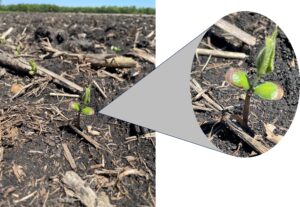Illinois Crop Update – May 19, 2023
Russ Higgins – Extension Commercial Ag Educator
Grundy County
Soil Conditions: Mildly Wet (soil is wetter than normal, local vegetation is healthy)
Mostly favorable growing conditions in NE Illinois. Spotty precipitation slowed some farmers who are trying to wrap up the 2023 planting season. Cooler soils slowed some soybean emergence, especially in high residue no-till fields. Those scouting soybean fields have reported some emerging soy exhibiting discolored cotyledons. Likely causes can include stressful emergence conditions, diseases, herbicide injury from pre-emergent herbicides (likely PPO-inhibiting herbicides whose injury to emerging soybeans is enhanced by cool and wet conditions). If the cotyledons have a distinctive “halo'” on the cotyledon and the soy planted was seed-treated with the fungicide fluopyram (ILeVO), the browning is the result of phytotoxicity caused by accumulation of the fungicide in the cotyledon. We encourage early season scouting but also suggest farmers observe their soybean fields for several days to a week of favorable growing conditions before making rash replant decisions. Soybeans are a resilient crop that often outgrow early season issues.

Figure 1: ILeVO-treated soybeans with “halo effect”. Grundy County, May 17, 2023
Doug Gucker – Extension Local Food Systems and Small Farms Educator
Piatt County
Soil Conditions: Mildly Dry (soil is drier than normal, plant growth may have slowed)
In Piatt County, the heavy rains of May 6 -8 have caused some emergence issues in fields planted ahead of those rains. Some fields have been rotary hoed and some not. Wheat fields have finished flowering and look good. Early planted crops are growing well, corn is at V4 and soybean at V2. Ponding damage is visible in poorly drained areas of fields. Only light rain has fallen in the past week.

Figure 2: Soil crusting causing emergence issues in a few fields.

Figure 3: Winter wheat that has finished flowering.
Talon Becker – Extension Commercial Agriculture Educator
Champaign County
Soil Conditions: Mildly Wet (soil is wetter than normal, local vegetation is healthy)
Most fields in the area are planted and emerged. The crop looks to be off to a good start in most fields, with the exception a few low spots where water is or was recently standing following the rains earlier this month. With minimal rain and some warmer temperatures in the near-term forecast, farmers in the area will likely finish up any planting and replanting they have to do in the next week or so.
Nathan Johanning – Extension Commercial Agriculture Educator
Monroe County
Soil Conditions: Mildly Dry (soil is drier than normal, plant growth may have slowed)
Most of our area has finally received some rainfall over the last week, but it has been scattered and highly variable. I have had reports of a few tenths to a few inches across the county. Much of the area has gotten about 3/4 to 1″, however, there is a band through the central part of the county that has only gotten a few tenths at best and even that was scattered across multiple days. I have a corn demonstration plot planted 5/3 that after 2 weeks has barely emerged, and soybeans planted that same time, again with very spotty emergence. Widespread rain is greatly needed. For those that have caught rain, crops responded almost overnight in growth. I have seen some of the largest corn fields at V3-4. PRE herbicide activation has been a concern with limited rainfall. Wheat continues to be quite happy with continued modest temperatures overall in the 70s and 80s and no excessive precipitation. We will get a better view of the wheat crop across the region next Tuesday at the Illinois Wheat Association Plot Tour, where farmer groups will canvas many of our wheat producing counties across the state, assessing crop quality and yield estimates. They will wrap up at the Belleville Research Center late afternoon to view plots and report crop observations.





